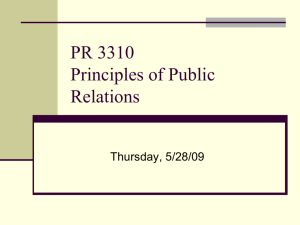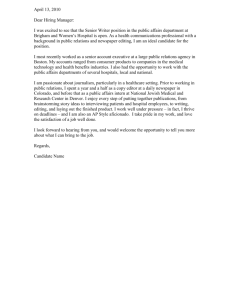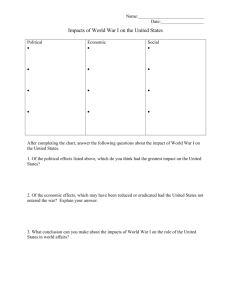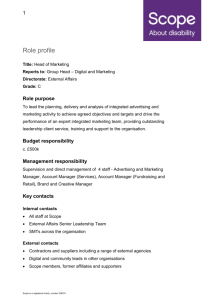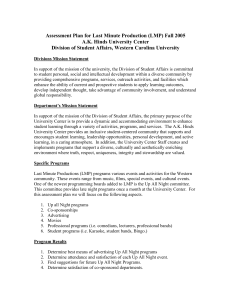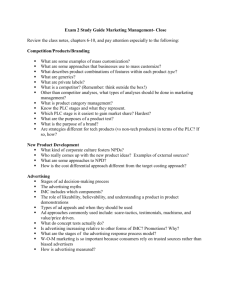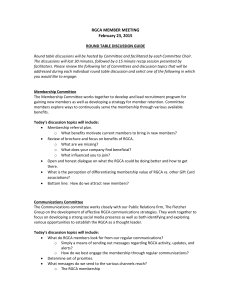What is Public Relations?
advertisement
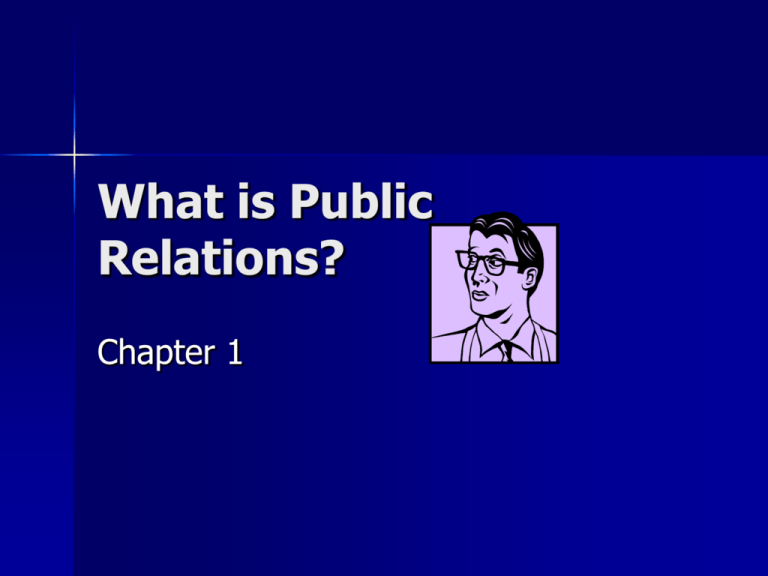
What is Public Relations? Chapter 1 Public Relations: a challenging career with plenty of variety – Two examples of PR pros and what they do at start of chapter (p.2) Nationally, 200,000 people work in the field (according to the U.S. Bureau of Labor Statistics). PR has been rated as one of the nation’s fastest growing industries, according to the U.S. Bureau of Labor Statistics. Fortune Magazine survey ranks PR No. 8 on a list of “Where the best jobs will be.” Globally, there are 155 national and regional PR associations with a membership of 137,000. PR: American Style The PR field is most extensively developed in the US where organizations spend an estimated $141 billion annually on PR, instore promotions, direct mail, and sponsorships with another $176 billion spent on advertising, according to estimates. PR is expected to grow almost 9 percent by 2008, more than any other communications practice except event planning and sponsorships. In the U.S. organizations spend an estimated $10 billion annually in PR activities. In the U.S. almost 200 universities have sequences or majors in PR and about 80 European universities also offer studies in PR. – C of C has a sequence in PR within the Communication Dept. – C of C also has a chapter of the Public Relations Student Society of America, one of only two such chapters in the state. Worldwide Growth PR activities and spending are also growing in Europe and even more so in Asia, particularly China were the economy is growing at the rate of 10 percent annually. DEFINING PUBLIC RELATIONS People often think of PR in terms of its most visible techniques and results: publicity in a newspaper, a TV interview with an organization’s spokesperson, or the appearance of a celebrity at a special event. PR is a process involving many subtle and far-reaching aspects. It includes research and analysis, policy formation, programming, communication, and feedback from numerous publics. DEFINING PR (cont’d) Its practitioners operate on two distinct levels—as advisers to their clients or to an organization’s top management and as technicians who produce and disseminate message in multi-media channels. PRSA definition—13 words: “Public relations helps an organization and its publics adapt mutually to each other.” Review key words on pages 6-7: deliberate, planned, performance, public interest, twoway communication, management function. PR as a Process The RACE acronym-Research, Action, Communication (execution) and Evaluation (p. 9) PR is a process, a series of actions, changes, or functions that bring about a result. A popular way to describe the process, and to remember its components, is RACE first used in “The Nature of Public Relations” by John Marston. Definitions of PR people as “linking agents” and “boundary spanners” who act to transfer information between two systems. Other terms for Public Relations To describe the public relations function within corporations, “corporate communications” is the most common name, according to a survey of the nation’s 500 largest corporations, used by 165 companies. “Public relations” used by 64. Other names are “public affairs, communication, corporate relations, and corporate public affairs. Social service agencies, universities and government agencies like “public information” or “community relations,” names which don’t imply the persuasive nature of PR communication. The military likes “public affairs.” C of C used to use “College Relations” but is now “Marketing and Communications.” Less Flattering Terms and Stereotypes “Sex in the City” reference, Samantha, the Kim Cattrall character, owns a PR agency– depiction on glamour, no “heavy lifting” or routine functions And the old Michael J. Fox series, “Spin City,” as the devious and manipulate deputy mayor/press secretary A 1993 study found that PR was consistently equated with “manipulation of the truth to a dubious end” but a more recent study of the media’s portrayal of PR is more favorable… “flacks” and “spin doctors” Specific PR jobs and roles (pages 10-11) Counseling Research Media relations Publicity Employment/ member relations Community relations Public affairs Government affairs Issues management Financial relations Industry relations Development/fundraising Special events Marketing communications Multicultural relations/workplace diversity THE RANGE OF PUBLIC RELATIONS Major areas of PR work include: corporations; nonprofit organizations; entertainment, sports, and travel; government and politics; education; and international public relations INTEGRATED MARKETING COMMUNICATIONS (IMC) The trend is toward more comprehensive planning involving a variety of communication disciplines— PR, advertising, marketing, sales promotion, direct response—and combines these disciplines to provide clarity, consistency and maximum communication impact. Reasons for IMC trend Downsizing and reengineering of organizations—many have combined departments and reduced staff dedicated to various communication disciplines…meaning one department, fewer employees, expected to do a greater variety of communication tasks Marketing and Communications Departments are making do with tighter budgets. Publicists and Press Agents: What’s the Difference? Publicists deal exclusively with placement of stories in the media. Press agents are also specialists who concentrate on finding unusual news angles and planning events or “happenings” that attract media attention. HOW PR DIFFERS FROM JOURNALISM, ADVERTISING, MARKETING These are important distinctions to make and understand – Journalism and PR differ in scope, objective, audience and channels- journalism serves the public, and PR services clients/causes – Advertising is paid for; PR utilizes “free media” opportunities and outlets – Marketing is concerned with customers and selling products and services; PR is concerned with building relationships and generating goodwill for the organizations Five Essential Abilities Writing skills Research ability Planning expertise Problem-solving ability Business/economics competence 10 QUALITIES THAT EMPLOYERS WANT (page 28) Good Writing Intelligence Cultural Literacy Know a good story when you see one Media Savvy Contacts Broad Communication Experience Specialized Experience Avoid Career Clichés FINALLY…. Take the PR Personality Checklist on page 31! Homework due next Thursday: Read Chapter 1. On pages 30-31 type responses to these Questions for Review: 2, 7, 8, 12, 16, 17, 18, 19, 21, 24 Remember no class Tuesday, Jan. 15

